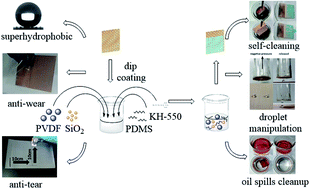Fabrication of a superhydrophobic mesh based on PDMS/SiO2 nanoparticles/PVDF microparticles/KH-550 by one-step dip-coating method†
Abstract
In this study, a facile one-step dip-coating approach was reported for fabrication of superhydrophobic copper mesh by using PDMS, SiO2 nanoparticles, PVDF microparticles and a couple agent 3-aminopropyltriethoxysilane (KH-550). It is found that undesirable SiO2 agglomeration was obviously reduced by introducing KH-550 and PVDF microparticles. The KH-550 acts as the bridge-linker and binds SiO2, PVDF and PDMS together. The as-prepared superhydrophobic mesh exhibited a promising water contact angle of 160.1° and a small sliding angle of 2.5°. The coating displayed excellent resistance to various pollutants and retained its superhydrophobicity after abrasions (sandpaper abrasion or adhesive tape tear). The strong chemical stability was also observed when the mesh was immersed in various solutions, especially in neutral and alkaline solutions. The applications of the superhydrophobic mesh for quantitative water droplet manipulation and oil spill cleanup were also illustrated. The method is facile and economic, and could be used for large-scale fabrications for industrial applications.



 Please wait while we load your content...
Please wait while we load your content...